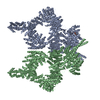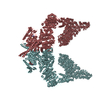[English] 日本語
 Yorodumi
Yorodumi- EMDB-9950: 4.27 Angstrom resolution cryo-EM structure of human dimeric ATM kinase -
+ Open data
Open data
- Basic information
Basic information
| Entry | Database: EMDB / ID: EMD-9950 | |||||||||
|---|---|---|---|---|---|---|---|---|---|---|
| Title | 4.27 Angstrom resolution cryo-EM structure of human dimeric ATM kinase | |||||||||
 Map data Map data | ||||||||||
 Sample Sample |
| |||||||||
 Keywords Keywords | DNA damage response / KInase / CELL CYCLE | |||||||||
| Function / homology |  Function and homology information Function and homology informationestablishment of RNA localization to telomere / positive regulation of telomerase catalytic core complex assembly / cellular response to nitrosative stress / negative regulation of telomere capping / establishment of protein-containing complex localization to telomere / Sensing of DNA Double Strand Breaks / peptidyl-serine autophosphorylation / positive regulation of telomere maintenance via telomere lengthening / meiotic telomere clustering / pre-B cell allelic exclusion ...establishment of RNA localization to telomere / positive regulation of telomerase catalytic core complex assembly / cellular response to nitrosative stress / negative regulation of telomere capping / establishment of protein-containing complex localization to telomere / Sensing of DNA Double Strand Breaks / peptidyl-serine autophosphorylation / positive regulation of telomere maintenance via telomere lengthening / meiotic telomere clustering / pre-B cell allelic exclusion / DNA-dependent protein kinase activity / extrinsic component of synaptic vesicle membrane / male meiotic nuclear division / histone H2AXS139 kinase activity / histone mRNA catabolic process / regulation of telomere maintenance via telomerase / female meiotic nuclear division / lipoprotein catabolic process / DNA double-strand break processing / regulation of autophagosome assembly / cellular response to X-ray / V(D)J recombination / oocyte development / pexophagy / Impaired BRCA2 binding to PALB2 / DNA repair complex / reciprocal meiotic recombination / positive regulation of DNA damage response, signal transduction by p53 class mediator / Homologous DNA Pairing and Strand Exchange / Defective homologous recombination repair (HRR) due to BRCA1 loss of function / Defective HDR through Homologous Recombination Repair (HRR) due to PALB2 loss of BRCA1 binding function / Defective HDR through Homologous Recombination Repair (HRR) due to PALB2 loss of BRCA2/RAD51/RAD51C binding function / Resolution of D-loop Structures through Synthesis-Dependent Strand Annealing (SDSA) / 1-phosphatidylinositol-3-kinase activity / Resolution of D-loop Structures through Holliday Junction Intermediates / HDR through Single Strand Annealing (SSA) / response to ionizing radiation / negative regulation of B cell proliferation / cellular response to stress / TP53 Regulates Transcription of Caspase Activators and Caspases / mitotic spindle assembly checkpoint signaling / positive regulation of double-strand break repair / Impaired BRCA2 binding to RAD51 / mitotic G2 DNA damage checkpoint signaling / TP53 Regulates Transcription of Genes Involved in Cytochrome C Release / peroxisomal matrix / Presynaptic phase of homologous DNA pairing and strand exchange / replicative senescence / signal transduction in response to DNA damage / Regulation of HSF1-mediated heat shock response / somitogenesis / ovarian follicle development / regulation of cellular response to heat / cellular response to retinoic acid / positive regulation of telomere maintenance via telomerase / negative regulation of TORC1 signaling / positive regulation of cell adhesion / telomere maintenance / Pexophagy / DNA damage checkpoint signaling / thymus development / regulation of signal transduction by p53 class mediator / determination of adult lifespan / post-embryonic development / cellular response to reactive oxygen species / TP53 Regulates Transcription of DNA Repair Genes / DNA damage response, signal transduction by p53 class mediator / Nonhomologous End-Joining (NHEJ) / Stabilization of p53 / Autodegradation of the E3 ubiquitin ligase COP1 / cellular response to gamma radiation / double-strand break repair via homologous recombination / G2/M DNA damage checkpoint / brain development / Regulation of TP53 Activity through Methylation / double-strand break repair via nonhomologous end joining / DNA Damage/Telomere Stress Induced Senescence / HDR through Homologous Recombination (HRR) / Meiotic recombination / multicellular organism growth / spindle / intrinsic apoptotic signaling pathway in response to DNA damage / cellular senescence / Regulation of TP53 Degradation / double-strand break repair / positive regulation of neuron apoptotic process / Recruitment and ATM-mediated phosphorylation of repair and signaling proteins at DNA double strand breaks / site of double-strand break / heart development / chromosome / protein autophosphorylation / Processing of DNA double-strand break ends / neuron apoptotic process / regulation of apoptotic process / Regulation of TP53 Activity through Phosphorylation / protein phosphorylation / non-specific serine/threonine protein kinase / regulation of cell cycle / regulation of autophagy / positive regulation of cell migration Similarity search - Function | |||||||||
| Biological species |  Homo sapiens (human) Homo sapiens (human) | |||||||||
| Method | single particle reconstruction / cryo EM / Resolution: 4.27 Å | |||||||||
 Authors Authors | Xiao J / Liu M | |||||||||
 Citation Citation |  Journal: Cell Res / Year: 2019 Journal: Cell Res / Year: 2019Title: Structural insights into the activation of ATM kinase. Authors: Jianxiong Xiao / Mengjie Liu / Yilun Qi / Yuriy Chaban / Chao Gao / Beiqing Pan / Yuan Tian / Zishuo Yu / Jie Li / Peijun Zhang / Yanhui Xu /   | |||||||||
| History |
|
- Structure visualization
Structure visualization
| Movie |
 Movie viewer Movie viewer |
|---|---|
| Structure viewer | EM map:  SurfView SurfView Molmil Molmil Jmol/JSmol Jmol/JSmol |
| Supplemental images |
- Downloads & links
Downloads & links
-EMDB archive
| Map data |  emd_9950.map.gz emd_9950.map.gz | 5.2 MB |  EMDB map data format EMDB map data format | |
|---|---|---|---|---|
| Header (meta data) |  emd-9950-v30.xml emd-9950-v30.xml emd-9950.xml emd-9950.xml | 12.5 KB 12.5 KB | Display Display |  EMDB header EMDB header |
| Images |  emd_9950.png emd_9950.png | 39.5 KB | ||
| Filedesc metadata |  emd-9950.cif.gz emd-9950.cif.gz | 6.9 KB | ||
| Archive directory |  http://ftp.pdbj.org/pub/emdb/structures/EMD-9950 http://ftp.pdbj.org/pub/emdb/structures/EMD-9950 ftp://ftp.pdbj.org/pub/emdb/structures/EMD-9950 ftp://ftp.pdbj.org/pub/emdb/structures/EMD-9950 | HTTPS FTP |
-Validation report
| Summary document |  emd_9950_validation.pdf.gz emd_9950_validation.pdf.gz | 358.2 KB | Display |  EMDB validaton report EMDB validaton report |
|---|---|---|---|---|
| Full document |  emd_9950_full_validation.pdf.gz emd_9950_full_validation.pdf.gz | 357.8 KB | Display | |
| Data in XML |  emd_9950_validation.xml.gz emd_9950_validation.xml.gz | 6.1 KB | Display | |
| Data in CIF |  emd_9950_validation.cif.gz emd_9950_validation.cif.gz | 6.9 KB | Display | |
| Arichive directory |  https://ftp.pdbj.org/pub/emdb/validation_reports/EMD-9950 https://ftp.pdbj.org/pub/emdb/validation_reports/EMD-9950 ftp://ftp.pdbj.org/pub/emdb/validation_reports/EMD-9950 ftp://ftp.pdbj.org/pub/emdb/validation_reports/EMD-9950 | HTTPS FTP |
-Related structure data
| Related structure data |  6k9lMC  9949C  9951C  6k9kC M: atomic model generated by this map C: citing same article ( |
|---|---|
| Similar structure data |
- Links
Links
| EMDB pages |  EMDB (EBI/PDBe) / EMDB (EBI/PDBe) /  EMDataResource EMDataResource |
|---|---|
| Related items in Molecule of the Month |
- Map
Map
| File |  Download / File: emd_9950.map.gz / Format: CCP4 / Size: 64 MB / Type: IMAGE STORED AS FLOATING POINT NUMBER (4 BYTES) Download / File: emd_9950.map.gz / Format: CCP4 / Size: 64 MB / Type: IMAGE STORED AS FLOATING POINT NUMBER (4 BYTES) | ||||||||||||||||||||||||||||||||||||||||||||||||||||||||||||||||||||
|---|---|---|---|---|---|---|---|---|---|---|---|---|---|---|---|---|---|---|---|---|---|---|---|---|---|---|---|---|---|---|---|---|---|---|---|---|---|---|---|---|---|---|---|---|---|---|---|---|---|---|---|---|---|---|---|---|---|---|---|---|---|---|---|---|---|---|---|---|---|
| Projections & slices | Image control
Images are generated by Spider. | ||||||||||||||||||||||||||||||||||||||||||||||||||||||||||||||||||||
| Voxel size | X=Y=Z: 1.62 Å | ||||||||||||||||||||||||||||||||||||||||||||||||||||||||||||||||||||
| Density |
| ||||||||||||||||||||||||||||||||||||||||||||||||||||||||||||||||||||
| Symmetry | Space group: 1 | ||||||||||||||||||||||||||||||||||||||||||||||||||||||||||||||||||||
| Details | EMDB XML:
CCP4 map header:
| ||||||||||||||||||||||||||||||||||||||||||||||||||||||||||||||||||||
-Supplemental data
- Sample components
Sample components
-Entire : Dimeric human ATM (Ataxia telangiectasia mutated) kinase
| Entire | Name: Dimeric human ATM (Ataxia telangiectasia mutated) kinase |
|---|---|
| Components |
|
-Supramolecule #1: Dimeric human ATM (Ataxia telangiectasia mutated) kinase
| Supramolecule | Name: Dimeric human ATM (Ataxia telangiectasia mutated) kinase type: organelle_or_cellular_component / ID: 1 / Parent: 0 / Macromolecule list: all |
|---|---|
| Source (natural) | Organism:  Homo sapiens (human) Homo sapiens (human) |
-Macromolecule #1: Serine-protein kinase ATM
| Macromolecule | Name: Serine-protein kinase ATM / type: protein_or_peptide / ID: 1 / Number of copies: 2 / Enantiomer: LEVO / EC number: non-specific serine/threonine protein kinase |
|---|---|
| Source (natural) | Organism:  Homo sapiens (human) Homo sapiens (human) |
| Molecular weight | Theoretical: 351.127688 KDa |
| Recombinant expression | Organism:  Homo sapiens (human) Homo sapiens (human) |
| Sequence | String: MSLVLNDLLI CCRQLEHDRA TERKKEVEKF KRLIRDPETI KHLDRHSDSK QGKYLNWDAV FRFLQKYIQK ETECLRIAKP NVSASTQAS RQKKMQEISS LVKYFIKCAN RRAPRLKCQE LLNYIMDTVK DSSNGAIYGA DCSNILLKDI LSVRKYWCEI S QQQWLELF ...String: MSLVLNDLLI CCRQLEHDRA TERKKEVEKF KRLIRDPETI KHLDRHSDSK QGKYLNWDAV FRFLQKYIQK ETECLRIAKP NVSASTQAS RQKKMQEISS LVKYFIKCAN RRAPRLKCQE LLNYIMDTVK DSSNGAIYGA DCSNILLKDI LSVRKYWCEI S QQQWLELF SVYFRLYLKP SQDVHRVLVA RIIHAVTKGC CSQTDGLNSK FLDFFSKAIQ CARQEKSSSG LNHILAALTI FL KTLAVNF RIRVCELGDE ILPTLLYIWT QHRLNDSLKE VIIELFQLQI YIHHPKGAKT QEKGAYESTK WRSILYNLYD LLV NEISHI GSRGKYSSGF RNIAVKENLI ELMADICHQV FNEDTRSLEI SQSYTTTQRE SSDYSVPCKR KKIELGWEVI KDHL QKSQN DFDLVPWLQI ATQLISKYPA SLPNCELSPL LMILSQLLPQ QRHGERTPYV LRCLTEVALC QDKRSNLESS QKSDL LKLW NKIWCITFRG ISSEQIQAEN FGLLGAIIQG SLVEVDREFW KLFTGSACRP SCPAVCCLTL ALTTSIVPGT VKMGIE QNM CEVNRSFSLK ESIMKWLLFY QLEGDLENST EVPPILHSNF PHLVLEKILV SLTMKNCKAA MNFFQSVPEC EHHQKDK EE LSFSEVEELF LQTTFDKMDF LTIVRECGIE KHQSSIGFSV HQNLKESLDR CLLGLSEQLL NNYSSEITNS ETLVRCSR L LVGVLGCYCY MGVIAEEEAY KSELFQKAKS LMQCAGESIT LFKNKTNEEF RIGSLRNMMQ LCTRCLSNCT KKSPNKIAS GFFLRLLTSK LMNDIADICK SLASFIKKPF DRGEVESMED DTNGNLMEVE DQSSMNLFND YPDSSVSDAN EPGESQSTIG AINPLAEEY LSKQDLLFLD MLKFLCLCVT TAQTNTVSFR AADIRRKLLM LIDSSTLEPT KSLHLHMYLM LLKELPGEEY P LPMEDVLE LLKPLSNVCS LYRRDQDVCK TILNHVLHVV KNLGQSNMDS ENTRDAQGQF LTVIGAFWHL TKERKYIFSV RM ALVNCLK TLLEADPYSK WAILNVMGKD FPVNEVFTQF LADNHHQVRM LAAESINRLF QDTKGDSSRL LKALPLKLQQ TAF ENAYLK AQEGMREMSH SAENPETLDE IYNRKSVLLT LIAVVLSCSP ICEKQALFAL CKSVKENGLE PHLVKKVLEK VSET FGYRR LEDFMASHLD YLVLEWLNLQ DTEYNLSSFP FILLNYTNIE DFYRSCYKVL IPHLVIRSHF DEVKSIANQI QEDWK SLLT DCFPKILVNI LPYFAYEGTR DSGMAQQRET ATKVYDMLKS ENLLGKQIDH LFISNLPEIV VELLMTLHEP ANSSAS QST DLCDFSGDLD PAPNPPHFPS HVIKATFAYI SNCHKTKLKS ILEILSKSPD SYQKILLAIC EQAAETNNVY KKHRILK IY HLFVSLLLKD IKSGLGGAWA FVLRDVIYTL IHYINQRPSC IMDVSLRSFS LCCDLLSQVC QTAVTYCKDA LENHLHVI V GTLIPLVYEQ VEVQKQVLDL LKYLVIDNKD NENLYITIKL LDPFPDHVVF KDLRITQQKI KYSRGPFSLL EEINHFLSV SVYDALPLTR LEGLKDLRRQ LELHKDQMVD IMRASQDNPQ DGIMVKLVVN LLQLSKMAIN HTGEKEVLEA VGSCLGEVGP IDFSTIAIQ HSKDASYTKA LKLFEDKELQ WTFIMLTYLN NTLVEDCVKV RSAAVTCLKN ILATKTGHSF WEIYKMTTDP M LAYLQPFR TSRKKFLEVP RFDKENPFEG LDDINLWIPL SENHDIWIKT LTCAFLDSGG TKCEILQLLK PMCEVKTDFC QT VLPYLIH DILLQDTNES WRNLLSTHVQ GFFTSCLRHF SQTSRSTTPA NLDSESEHFF RCCLDKKSQR TMLAVVDYMR RQK RPSSGT IFNDAFWLDL NYLEVAKVAQ SCAAHFTALL YAEIYADKKS MDDQEKRSLA FEEGSQSTTI SSLSEKSKEE TGIS LQDLL LEIYRSIGEP DSLYGCGGGK MLQPITRLRT YEHEAMWGKA LVTYDLETAI PSSTRQAGII QALQNLGLCH ILSVY LKGL DYENKDWCPE LEELHYQAAW RNMQWDHCTS VSKEVEGTSY HESLYNALQS LRDREFSTFY ESLKYARVKE VEEMCK RSL ESVYSLYPTL SRLQAIGELE SIGELFSRSV THRQLSEVYI KWQKHSQLLK DSDFSFQEPI MALRTVILEI LMEKEMD NS QRECIKDILT KHLVELSILA RTFKNTQLPE RAIFQIKQYN SVSCGVSEWQ LEEAQVFWAK KEQSLALSIL KQMIKKLD A SCAANNPSLK LTYTECLRVC GNWLAETCLE NPAVIMQTYL EKAVEVAGNY DGESSDELRN GKMKAFLSLA RFSDTQYQR IENYMKSSEF ENKQALLKRA KEEVGLLREH KIQTNRYTVK VQRELELDEL ALRALKEDRK RFLCKAVENY INCLLSGEEH DMWVFRLCS LWLENSGVSE VNGMMKRDGM KIPTYKFLPL MYQLAARMGT KMMGGLGFHE VLNNLISRIS MDHPHHTLFI I LALANANR DEFLTKPEVA RRSRITKNVP KQSSQLDEDR TEAANRIICT IRSRRPQMVR SVEALCDAYI ILANLDATQW KT QRKGINI PADQPITKLK NLEDVVVPTM EIKVDHTGEY GNLVTIQSFK AEFRLAGGVN LPKIIDCVGS DGKERRQLVK GRD DLRQDA VMQQVFQMCN TLLQRNTETR KRKLTICTYK VVPLSQRSGV LEWCTGTVPI GEFLVNNEDG AHKRYRPNDF SAFQ CQKKM MEVQKKSFEE KYEVFMDVCQ NFQPVFRYFC MEKFLDPAIW FEKRLAYTRS VATSSIVGYI LGLGDRHVQN ILINE QSAE LVHIDLGVAF EQGKILPTPE TVPFRLTRDI VDGMGITGVE GVFRRCCEKT MEVMRNSQET LLTIVEVLLY DPLFDW TMN PLKALYLQQR PEDETELHPT LNADDQECKR NLSDIDQSFN KVAERVLMRL QEKLKGVEEG TVLSVGGQVN LLIQQAI DP KNLSRLFPGW KAWV UniProtKB: Serine-protein kinase ATM |
-Experimental details
-Structure determination
| Method | cryo EM |
|---|---|
 Processing Processing | single particle reconstruction |
| Aggregation state | particle |
- Sample preparation
Sample preparation
| Buffer | pH: 7.4 |
|---|---|
| Grid | Model: Quantifoil R1.2/1.3 / Material: GOLD / Mesh: 300 / Pretreatment - Type: GLOW DISCHARGE / Pretreatment - Time: 60 sec. / Pretreatment - Atmosphere: AIR |
| Vitrification | Cryogen name: ETHANE / Chamber humidity: 100 % / Chamber temperature: 282 K / Instrument: FEI VITROBOT MARK IV |
- Electron microscopy
Electron microscopy
| Microscope | FEI TITAN KRIOS |
|---|---|
| Image recording | #0 - Image recording ID: 1 / #0 - Film or detector model: FEI FALCON III (4k x 4k) / #0 - Average electron dose: 32.0 e/Å2 / #1 - Image recording ID: 2 / #1 - Film or detector model: GATAN K2 SUMMIT (4k x 4k) / #1 - Average electron dose: 38.0 e/Å2 |
| Electron beam | Acceleration voltage: 300 kV / Electron source:  FIELD EMISSION GUN FIELD EMISSION GUN |
| Electron optics | Illumination mode: OTHER / Imaging mode: BRIGHT FIELD |
| Experimental equipment |  Model: Titan Krios / Image courtesy: FEI Company |
 Movie
Movie Controller
Controller





























 Z (Sec.)
Z (Sec.) Y (Row.)
Y (Row.) X (Col.)
X (Col.)





















